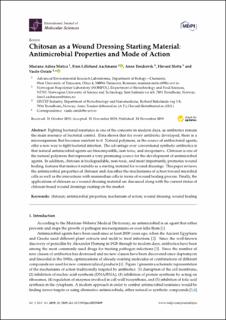| dc.contributor.author | Matica, Mariana Adina | |
| dc.contributor.author | Aachmann, Finn Lillelund | |
| dc.contributor.author | Tøndervik, Anne | |
| dc.contributor.author | Sletta, Håvard | |
| dc.contributor.author | Ostafe, Vasile | |
| dc.date.accessioned | 2020-11-26T12:54:50Z | |
| dc.date.available | 2020-11-26T12:54:50Z | |
| dc.date.created | 2020-01-07T14:43:21Z | |
| dc.date.issued | 2019 | |
| dc.identifier.issn | 1422-0067 | |
| dc.identifier.uri | https://hdl.handle.net/11250/2689802 | |
| dc.description.abstract | Fighting bacterial resistance is one of the concerns in modern days, as antibiotics remain the main resource of bacterial control. Data shows that for every antibiotic developed, there is a microorganism that becomes resistant to it. Natural polymers, as the source of antibacterial agents, offer a new way to fight bacterial infection. The advantage over conventional synthetic antibiotics is that natural antimicrobial agents are biocompatible, non-toxic, and inexpensive. Chitosan is one of the natural polymers that represent a very promising source for the development of antimicrobial agents. In addition, chitosan is biodegradable, non-toxic, and most importantly, promotes wound healing, features that makes it suitable as a starting material for wound dressings. This paper reviews the antimicrobial properties of chitosan and describes the mechanisms of action toward microbial cells as well as the interactions with mammalian cells in terms of wound healing process. Finally, the applications of chitosan as a wound-dressing material are discussed along with the current status of chitosan-based wound dressings existing on the market. | en_US |
| dc.language.iso | eng | en_US |
| dc.publisher | MDPI | en_US |
| dc.rights | Navngivelse 4.0 Internasjonal | * |
| dc.rights.uri | http://creativecommons.org/licenses/by/4.0/deed.no | * |
| dc.subject | wound healing | en_US |
| dc.subject | wound dressing | en_US |
| dc.subject | mechanism of action | en_US |
| dc.subject | antimicrobial properties | en_US |
| dc.subject | chitosan | en_US |
| dc.title | Chitosan as a wound dressing starting material: antimicrobial Properties and mode of action | en_US |
| dc.type | Peer reviewed | en_US |
| dc.type | Journal article | en_US |
| dc.description.version | publishedVersion | en_US |
| dc.rights.holder | © 2019 by the authors. Licensee MDPI, Basel, Switzerland. This article is an open access article distributed under the terms and conditions of the Creative Commons Attribution (CC BY) license (http://creativecommons.org/licenses/by/4.0/). | en_US |
| dc.source.pagenumber | 33 | en_US |
| dc.source.volume | 20 | en_US |
| dc.source.journal | International Journal of Molecular Sciences | en_US |
| dc.source.issue | 23 | en_US |
| dc.identifier.doi | 10.3390/ijms20235889 | |
| dc.identifier.cristin | 1767833 | |
| dc.source.articlenumber | 5889 | en_US |
| cristin.unitcode | 7401,80,1,0 | |
| cristin.unitname | Bioteknologi og nanomedisin | |
| cristin.ispublished | true | |
| cristin.fulltext | original | |
| cristin.qualitycode | 1 | |

